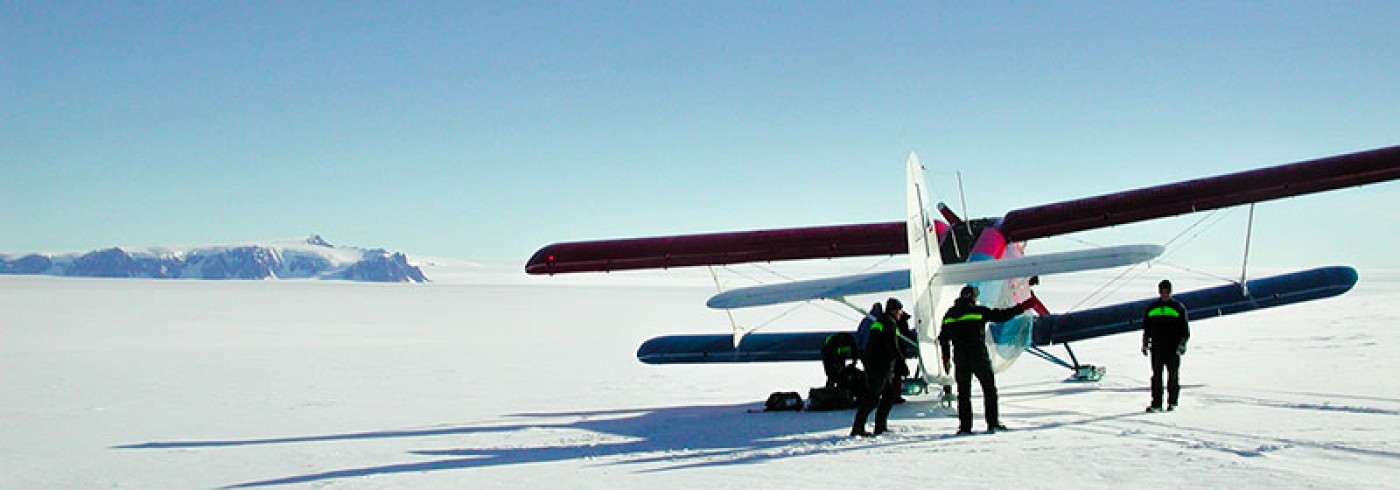Evaluation of air transportation between South Africa and Antarctica: feasibility study of a runway at the Troll station
Introduction
In the season 2000/01 Australia, Finland, Germany, Japan, the Netherlands, Norway, South Africa and Sweden, co-ordinated by Jan Erling Haugland, made an evaluation of flights between Cape Town and Dronning Maud Land (DML), as well as flights within DML. As a consequence, in the season 2001/02 Norway, Russia, and Sweden carried out a feasibility study of an ice runway close to the Norwegian Troll station. Troll is centrally placed in DML.
The six members of the team were highly skilled land surveyors, pilots and air operations managers, two of each profession. Their main objectives were to survey a major blue-ice field some eight kilometres from Troll and to make a feasibility study of its use as a landing site for heavy wheeled aircraft. The study was made on 30–31 January 2002.
Field survey results
Aerial observations were carried out from a helicopter on 30 January. After several runs by helicopter along thetransition line an appropriate terrain was discovered at the northwest corner of the blue-ice field. The ground part of the reconnaissance included differential static and kinematic ground surveys undertaken by the Norwegian and Russian surveyors to determine the runway alignment and gradients. Both the longitudinal and transverse gradient values of the runway ice surface were acceptable. Ground inspection of the ice surface revealed that it was lightly undulated. A specific form of melting was found at the runway site, namely frozen melt cavities caused by the absorption and trapping of solar energy on the mineral particles blown down from the mountain surrounding the blueice. This melting takes place at the height of the summer. The melt process leads to the concentration of the mineral particles into substantial patches that cause deep melt cavities. These cavities have a round form and vertical walls, with a diameter of 10 to 70 cm and a depth of 30 to 50 cm. Such deep holes would be disastrous to any wheeled aircraft.
Conclusions
The inspected blue-ice field near the Troll Station demonstrated excellent potential for use as a blue-ice runway. The surface gradients and take-off path meet aviation standards. There is enough room to set up a full-scale runway for big-wheeled aircraft.
The approach and departure sectors of the flight path are almost free from obstructions. An easy ice surface treatment has to be carried out to prepare a runway. A heavy snow drag should be used to scrape down ripples from the ice surface and to cut off small ice bumps, thus reducing surface undulation and filling out melt cavities. Regular levelling of the runway surface by a scarifying heavy snow drag is therefore the only required treatment in periods when the site is not affected by melting. A mixture of snow and ice particles will become stronger with time because of sintering. Such cover will protect the runway from occasional melting and improve the frictional parameters for landing. At the peak of the melting season, a period of some 3–4 weeks, the runway may not be operational due to melt cavity formation. However, techniques will be tested to see if such formation can be completely avoided.
Dates
January 2002
Participants
Project leader
Magnus Augner
Swedish Polar Research Secretariat
Stockholm, Sweden
Göran Wästhed
Air Transport School, The Skaraborg Air Force Base, F7
Såtenäs, Sweden

